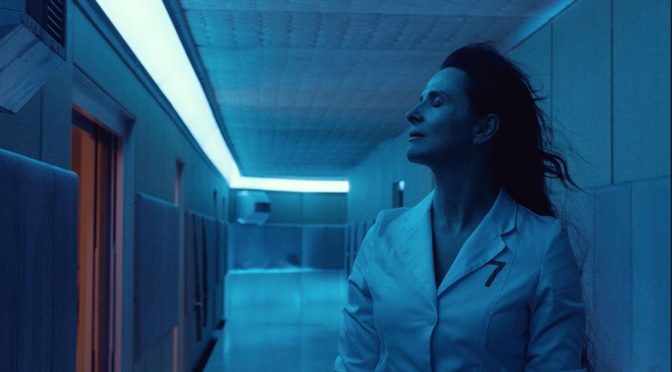Claire Denis has created a simple yet profound portrait of humanity in HIGH LIFE. In musing on her subjects, the film feels like a curiously muted piece of psychedelia, rooted in the traditional language of sci-fi but with an entirely different speech pattern. It recalls the best of the genre, yet deviates from them all.
Robert Pattinson leads the cast as Monte, a convict in deep space caring for his young daughter. Sent to harvest energy from black holes for non-incarcerated humanity, he was previously part of a larger crew including fellow convicts such as procreation-obsessed mad scientist Dibs (Juliette Binoche), conducting experiments towards artificial insemination. In an eerily disturbing pre-credits sequence we see what has become of them in the present. The film then proceeds to slip through narrative wormholes to past and future events, covering the fates of those on board and their interactions.
One of the first sights we see in HIGH LIFE is the garden: a lush green space to which the prisoners tends. The set design here is very reminiscent of Douglas Trumbull’s SILENT RUNNING. It immediately sets up an inversion of an Eden-like spot; a slice of paradise within the bleak penal surroundings, ready for corruption by human instincts and temptations. In Trumbull’s feature an abstract commercialism threatened this idyll, here it is merely humans themselves – condemned men and women untethered from life and responsibility on Earth.
“[HIGH LIFE] recalls the best of the genre, yet deviates from them all.”
Dibs harvests semen from the men, except the celibate Monte who rejects her sexual advances and spurns use of ‘the box’, a sex-toy-equipped chamber that automatically cleanses itself after each (frequent) use by the crew. The full release offered by it is demonstrated in an arresting early sequence featuring Binoche, functioning and lingering thereafter as the carnal background radiation underneath the film’s more periodic emissions of energy.
Some of the best and worst sci-fi has examined what drives the human race, using fantastical settings or beings to tease out what their makers see as the essence of human life. HIGH LIFE roots its view in the altogether more pedestrian-seeming world of bodily functions. For Denis’s film, there is an endless fascination in the feelings that drive these: pleasure, pain, relief, confusion, fear, power. Her characters seek these out in their most base forms and in ways varying from the beautiful, through awkward and raw, to the repulsive and dehumanising. Her work with colour complements the primal actions with primary hues – neon blues, intense reds, and a sickly yellow beige frequently flood the screen.
“By exploring such a base level of human instinct, HIGH LIFE comes full circle to occupy the same philosophical high ground as its supposedly loftier-minded forebears.”
By exploring such a base level of human instinct, HIGH LIFE comes full circle to occupy the same philosophical high ground as its supposedly loftier-minded forebears. Many stories have tried to present what it means to be human, but HIGH LIFE instead goes after what it feels like to be human. When we are stripped of our earth-bound pomp and ceremony (or during incarceration), what is left and what can we move towards besides a black hole?
Throughout, the visuals are stunning and are used to underpin this analysis in the more fantastical language of sci-fi. SILENT RUNNING, SOLARIS, ALIEN, 2001 and even recent entries such as INTERSTELLAR feel a part of this overlapping Venn diagram of philosophical concerns and analyses of human behaviour. HIGH LIFE, however, has carved out its own area that doesn’t overlap. HIGH LIFE is a story so simple it loops back to the profound and so focused on its characters it collapses through the event horizon to feel universal.

